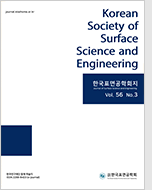
- Past Issues
- e-Submission
-

2021 Impact Factor 1.766
5-Year Impact Factor 1.674
Editorial Office
- +82-2-563-0935
- +82-2-558-2230
- submission@kssse.or.kr
- https://www.kssse.or.kr/

2021 Impact Factor 1.766
5-Year Impact Factor 1.674
The Korean Society of Surface Science and Engineering 2023;56(3):169-179. Published online: Jun, 27, 2023
DOI : 10.5695/JSSE.2023.56.3.169
This work studies dielectric breakdown behavior of AAO (anodic aluminum oxide) films formed on pure aluminum at a constant current density in 5 ~ 20 vol.% sulfuric acid (SA) and 2 ~ 8 wt.% oxalic acid (OA) solutions. It was observed that dielectric breakdown voltage of AAO film with the same thickness increased with increasing concentration of both SA and OA solutions up to 15 vol.% and 6 wt.%, respectively, above which it decreased slightly. The dielectric breakdown resistance of the OA films appeared to be superior to that of SA films. After dielectric breakdown test, cracks and a hole were observed. The crack length increased with increasing SA film thickness but it did not increase with increasing OA film thickness. To explain the reason why shorter cracks formed on the OA films than the SA films after dielectric breakdown test, the generation of tensile stresses at the oxide/ metal interface was discussed in relation to porosity of AAO films obtained from cross-sectional morphologies.
Keywords Anodic oxide film; Dielectric breakdown; Sulfuric acid; Oxalic acid; Aluminum.